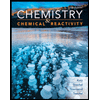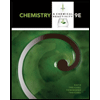
Laboratory Experiments For Chemistry: The Central Science, Si Edition
14th Edition
ISBN: 9781292221335
Author: Theodore E. Brown
Publisher: PEARSON
expand_more
expand_more
format_list_bulleted
Textbook Question
Chapter 15.7, Problem 15.12.1PE
Practice Exercise 1
For the reaction
4 NH3(g) + 5 O2(g) ⇌ 4 NO(g) + 6H2O(g) ΔH° = - 90KJ
Which of the following changes will shift the equilibrium to the right, toward the formation of more products?
- Adding more water vapor
- Increasing the temperature
- Increasing the volume of the reaction vessel
- Removing O2(g)
- Adding 1 atm of Ne(g) to the reaction vessel.
Expert Solution & Answer
Want to see the full answer?
Check out a sample textbook solution
Students have asked these similar questions
Given the elementary reactions in an aqueous medium with an ionic strength of 0.001:1) CH3Br + OH- → CH3OH + Br-2) ClCH2COO- + OH- → HOCH2COO- + Cl-3) [Co(NH3)5Br]2+ + NO2- →[Co(NH3)5NO2]2+ + Br-If the ionic strength is decreased, 1) k will not change; 2) k will decrease; and 3) k will increase. Is this correct?
Relate zero ionic strength and infinite dilution limit.
The photolysis of H3C–N=N–C2H5 involves the breaking of the single bonds shown. According to this, in addition to N2, what products would be obtained primarily if the reaction were carried out in the gas phase or in solution in an inert solvent?
Chapter 15 Solutions
Laboratory Experiments For Chemistry: The Central Science, Si Edition
Ch. 15.2 - Prob. 15.1.1PECh. 15.2 - Prob. 15.1.2PECh. 15.2 - Prob. 15.2.1PECh. 15.2 - Prob. 15.2.2PECh. 15.3 - Prob. 15.3.1PECh. 15.3 - Practice Exercise 2 For the reaction H2 (g) + I2...Ch. 15.3 - Prob. 15.4.1PECh. 15.3 - Prob. 15.4.2PECh. 15.4 - Prob. 15.5.1PECh. 15.4 - Prob. 15.5.2PE
Ch. 15.4 - Practice Exercise 1
If 8.0 g of NH4HS(s)...Ch. 15.4 - Prob. 15.6.2PECh. 15.5 - Practice Exercise 1
A mixture of gaseous sulfur...Ch. 15.5 - Prob. 15.7.2PECh. 15.5 - Practice Exercise 1 In Section 15.1, we discussed...Ch. 15.5 - Practice Exercise 2
The gaseous compound BrCl...Ch. 15.6 - Prob. 15.9.1PECh. 15.6 - Practice Exercise 2 At 1000 k, the value of Kp for...Ch. 15.6 - Prob. 15.10.1PECh. 15.6 - Prob. 15.10.2PECh. 15.6 - Practice Exercise 1 For the equilibrium Br2(g) +...Ch. 15.6 - Prob. 15.11.2PECh. 15.7 - Practice Exercise 1 For the reaction 4 NH3(g) + 5...Ch. 15.7 - Prob. 15.12.2PECh. 15 - Prob. 1DECh. 15 - Based on the following energy profile, predict...Ch. 15 - 15.2 The following diagrams represent a...Ch. 15 - Prob. 3ECh. 15 - Prob. 4ECh. 15 - Prob. 5ECh. 15 - 15.6 Ethene (C2H4) reacts with healogens (X2) by...Ch. 15 - When lead(IV) oxide is heated above 300 O C, it...Ch. 15 - Prob. 8ECh. 15 - The reactin A2(g) + B(g) + A(g) + AB(g) has an...Ch. 15 - Prob. 10ECh. 15 - Prob. 11ECh. 15 - The following graph represents the yield of the...Ch. 15 - Suppose that the gas-phase reactions A B and B A...Ch. 15 - Prob. 14ECh. 15 - Prob. 15ECh. 15 - Write the expression for KC for the following...Ch. 15 - When the following reaction come to equilibrium,...Ch. 15 - Prob. 18ECh. 15 - Prob. 19ECh. 15 - Prob. 20ECh. 15 - If Kc = 0.042 for PC13(g) + C12 (g) PC15 (g) at...Ch. 15 - Prob. 22ECh. 15 - 15.23 The equilibrium constant for the...Ch. 15 - Prob. 24ECh. 15 - Prob. 25ECh. 15 - Prob. 26ECh. 15 - The following equilibria were attained at 823 K:...Ch. 15 - Consider the equilibrium N2(g) + O2(g) + Br2(g) 2...Ch. 15 - Mercury(I) oxide decomposes into elemental mercury...Ch. 15 - Prob. 30ECh. 15 - Prob. 31ECh. 15 - Prob. 32ECh. 15 - Prob. 33ECh. 15 - Phosphorus trichloride gas and chlorine gas react...Ch. 15 - A mixture of 0.10 mol of NO, 0.050 mol of H2, and...Ch. 15 - Prob. 36ECh. 15 - A mixture of 0.2000 mol of CO2, 0.1000 mol of H2,...Ch. 15 - 15.38 A flask is charged with 1.500 atm of N2O4(g)...Ch. 15 - Prob. 39ECh. 15 - Prob. 40ECh. 15 - a. If QC KC, in which direction will a reaction...Ch. 15 - Prob. 42ECh. 15 - At 100 OC , the equilibrium constant for the...Ch. 15 - 15.44 As shown in Table 15.2, KP for the...Ch. 15 - At 100 C, K = 0.078 for the reaction SO2Cl2 (g) ...Ch. 15 - Prob. 46ECh. 15 - Prob. 47ECh. 15 - Prob. 48ECh. 15 - At 800 k, the equilibrium constant for I2 (g) ...Ch. 15 - Prob. 50ECh. 15 - At 2000 OC, the equilibrium constant for the...Ch. 15 - For the equilibrium Br2 (g) + Cl2 (g) 2BrCl(g) At...Ch. 15 - At 373 k, Kp = 0.416 for the equilibrium 2NOBr (g)...Ch. 15 - At 218 oC, KC= 1.2 X 10-4 for the equilibrium NH4...Ch. 15 - Prob. 55ECh. 15 - At 80 oC, K =1.87 X 10-3 for the reaction PH3 BCl3...Ch. 15 - Prob. 57ECh. 15 - Prob. 58ECh. 15 - Prob. 59ECh. 15 - Prob. 60ECh. 15 - Consider the following equilibrium for which H<0...Ch. 15 - Prob. 62ECh. 15 - 15.63 How do the following changes affect the...Ch. 15 - Prob. 64ECh. 15 - Consider the following equilibrium between oxides...Ch. 15 - Prob. 66ECh. 15 - Ozone, O3, decomposes to molecular oxygen in the...Ch. 15 - Prob. 68ECh. 15 - Prob. 69ECh. 15 - 15.70 True or false: When the temperature of an...Ch. 15 - Prob. 71AECh. 15 - Prob. 72AECh. 15 - 15.73 A mixture of CH4 and H2O is passed over a...Ch. 15 - Prob. 74AECh. 15 - Prob. 75AECh. 15 - Prob. 76AECh. 15 - Prob. 77AECh. 15 - Prob. 78AECh. 15 - Prob. 79AECh. 15 - For the equilibrium PH3BCI3 (s) PH3 (g) + BCI3...Ch. 15 - Prob. 81AECh. 15 - Prob. 82AECh. 15 - Prob. 83AECh. 15 - At 900 o C, Kc = 0.0108 for the reaction CaCO3(g) ...Ch. 15 - Prob. 85AECh. 15 - The equilibrium constant Kc for C(s) +CO2 2CO(g)...Ch. 15 - Prob. 87AECh. 15 - Le Chatelier noted that many industrial processes...Ch. 15 - Prob. 89AECh. 15 - Prob. 90AECh. 15 - [15.91] An equilibrium mixture of H2, I2, and HI...Ch. 15 - Consider the hypothetical reaction A(g) + 2B(g) 2...Ch. 15 - Prob. 93AECh. 15 - Prob. 94AECh. 15 - Prob. 95IECh. 15 - The following equilibria were measured at 823 K:...Ch. 15 - Prob. 97IECh. 15 - Prob. 98IECh. 15 - At 800 K, the equilibrium constant for the...Ch. 15 - Prob. 100IECh. 15 - Prob. 101IECh. 15 - Prob. 102IE
Knowledge Booster
Learn more about
Need a deep-dive on the concept behind this application? Look no further. Learn more about this topic, chemistry and related others by exploring similar questions and additional content below.Similar questions
- Given a keto-enol tautomerization reaction, which is greatly influenced by the type of solvent, indicate which of the following solvent properties cannot be considered a "solvent effect"?(A) Dielectric constant(B) Polarity(C) Hydrogen bonding capacity(D) Temperaturearrow_forwardIn solution reactions, what does "solvent effect" mean?arrow_forwardHow to solvearrow_forward
- Indicate the concentration and ionic strength ranges to which the Debye-Huckel equation can be applied. And the Davies equation?arrow_forwardIf the ionic strength (I) of a solution is very low, the Debye-Huckel equation is used. If I is higher, the Davies equation is used. What is the correct value for I to use one or the other?arrow_forwardIn both the Debye-Huckel equation and the Davies equation, there is a constant A. I see that sometimes it appears as 0.51 and other times as 1.02. Explain why one or the other value is used.arrow_forward
- The two equations are forms of the Davies equation, used in thermodynamics for activity coefficients: ال log Y₁ = -Az² - 0,31 log = Az² - 0,31 1 + √Ĩ 1 + √√ k These equations are consistent and imply that Yi = Is this last equation correct? karrow_forwardThe two equations are forms of the Davies equation, used in thermodynamics for activity coefficients: ال log Y₁ = -Az² - 0,31 log = Az² - 0,31 1 + √Ĩ 1 + √√ k These equations are consistent and imply that Yi = Is this last equation correct? karrow_forwardFor the Davies equation, both expressions are correct: log Y₁ = -Az² √i - 0,31 1 + √ k log- = Az - 0,31 k 1 + √Ĩarrow_forward
- k In Davies' equation log y₁ = log- log y₁ = log | = -Az² + ✓// k A is a constant that always equals 1.02. Correct? - 0,31arrow_forwardIndicate whether the equality is true Yi How is it obtained? k%arrow_forwardIndicate the relationship between the activity coefficient YA and the rate constant of a bimolecular reaction in solution k and the rate constant at infinite dilution ko.arrow_forward
arrow_back_ios
SEE MORE QUESTIONS
arrow_forward_ios
Recommended textbooks for you
 Chemistry & Chemical ReactivityChemistryISBN:9781337399074Author:John C. Kotz, Paul M. Treichel, John Townsend, David TreichelPublisher:Cengage Learning
Chemistry & Chemical ReactivityChemistryISBN:9781337399074Author:John C. Kotz, Paul M. Treichel, John Townsend, David TreichelPublisher:Cengage Learning Chemistry & Chemical ReactivityChemistryISBN:9781133949640Author:John C. Kotz, Paul M. Treichel, John Townsend, David TreichelPublisher:Cengage Learning
Chemistry & Chemical ReactivityChemistryISBN:9781133949640Author:John C. Kotz, Paul M. Treichel, John Townsend, David TreichelPublisher:Cengage Learning Chemistry: The Molecular ScienceChemistryISBN:9781285199047Author:John W. Moore, Conrad L. StanitskiPublisher:Cengage Learning
Chemistry: The Molecular ScienceChemistryISBN:9781285199047Author:John W. Moore, Conrad L. StanitskiPublisher:Cengage Learning

Chemistry & Chemical Reactivity
Chemistry
ISBN:9781337399074
Author:John C. Kotz, Paul M. Treichel, John Townsend, David Treichel
Publisher:Cengage Learning

Chemistry & Chemical Reactivity
Chemistry
ISBN:9781133949640
Author:John C. Kotz, Paul M. Treichel, John Townsend, David Treichel
Publisher:Cengage Learning

Chemistry: The Molecular Science
Chemistry
ISBN:9781285199047
Author:John W. Moore, Conrad L. Stanitski
Publisher:Cengage Learning
Chemical Equilibria and Reaction Quotients; Author: Professor Dave Explains;https://www.youtube.com/watch?v=1GiZzCzmO5Q;License: Standard YouTube License, CC-BY